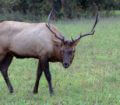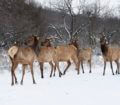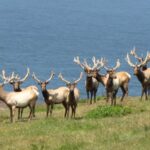John’s Note: Mike Lee, formerly from Montana but now living in Oregon, has been hunting elk for about 38 years – both on Montana and Oregon public lands. According to Lee, “Because I like to work from the ridgeline of mountains down to the lower elevations, I hunt in trees and dark timber most of the time. So, if I’m calling an elk from down below me, more than likely, I’ll meet him in the timber.”
 In 2014, I was hunting in Montana with a friend of mine. We had pre-season scouted together, and we both knew the area we wanted to hunt. In the morning, we had watched a herd of elk coming off private land and heading to the High Country. But to get to a spot where we could intersect the elk on public land, we would have to walk about 4-1/2-miles to get into position. We left the truck about 3:30 am to cover the distance in the dark before daylight. When we were about 400 or 500 yards from the place where we wanted to take a stand, we started hearing elk bugling all the way around us. We stopped, sat down and waited. As the sky lightened up, we could see elk for 360 degrees around us. As the sun climbed higher in the sky, we strained our eyes to look for bulls. While we were trying to decide what we were going to do, a spike bull walked 10 feet behind us and almost stepped on us. Needless to say, we both got really excited. When the spike finally ran off, we spotted a very-good bull in the trees and four other bulls on the hillside above us, about 600 – 800 yards away. As my friend and I whispered about what we thought would be the best game plan, a bull bugled right behind us. We turned to look and saw two 6×6 bulls about 200 yards from us. We slowly turned around, got good rests and both shot at the same time. This was on opening morning and only 15 minutes after legal shooting time. We had two 6×6 bulls down already, and this was one of the greatest elk hunts I’d ever had.
In 2014, I was hunting in Montana with a friend of mine. We had pre-season scouted together, and we both knew the area we wanted to hunt. In the morning, we had watched a herd of elk coming off private land and heading to the High Country. But to get to a spot where we could intersect the elk on public land, we would have to walk about 4-1/2-miles to get into position. We left the truck about 3:30 am to cover the distance in the dark before daylight. When we were about 400 or 500 yards from the place where we wanted to take a stand, we started hearing elk bugling all the way around us. We stopped, sat down and waited. As the sky lightened up, we could see elk for 360 degrees around us. As the sun climbed higher in the sky, we strained our eyes to look for bulls. While we were trying to decide what we were going to do, a spike bull walked 10 feet behind us and almost stepped on us. Needless to say, we both got really excited. When the spike finally ran off, we spotted a very-good bull in the trees and four other bulls on the hillside above us, about 600 – 800 yards away. As my friend and I whispered about what we thought would be the best game plan, a bull bugled right behind us. We turned to look and saw two 6×6 bulls about 200 yards from us. We slowly turned around, got good rests and both shot at the same time. This was on opening morning and only 15 minutes after legal shooting time. We had two 6×6 bulls down already, and this was one of the greatest elk hunts I’d ever had.
 Since we were only 3-1/2-miles from the truck, we helped each other field dress and quarter each elk. We used the gutless method of getting our meat by:
Since we were only 3-1/2-miles from the truck, we helped each other field dress and quarter each elk. We used the gutless method of getting our meat by:
- taking our knives and cutting the hide from the base of the tail up the backbone all the way up to the base of the elk’s ears;
- skinning the hide down about a foot on either side of the front shoulders, cutting behind the front shoulder and around the hide and removing the front shoulder;
- skinning the hide down just a little bit farther to take the hindquarter off the elk the same way we’d removed the front shoulder;
- taking the back strap out; and
- reaching in behind the last rib and using my index finger and my thumb to pinch behind the tenderloin – disconnecting the tenderloin at each end of the meat, so it came out in one piece.
Then, we flipped the elk over and used the same procedure to get the meat off the other side. With two people working on the same elk, we got all the meat off one elk in about 30 minutes. We had the meat for both elk and were ready to start packing out in only about an hour.
Here’s the way we pack out. One of us carries a hindquarter and a meat bag with tenderloins, backstraps, neck roasts and some of the rib meat. The other hunter carries out both front shoulders. After putting the meat in the truck, we go back and get the second load. On the third trip, we bring out the head and any other meat that we have. On this day, as we were coming out with our third load, we met some hunters on horseback who had harvested elk and had their elk packed in their panniers on their horses. They carried one of the heads out for us on our last trip.
 To get John and Denise Phillips’ free cookbook, “Miz Denise’s Outdoor Cooking: More than 35 Recipes for Elk and Mule Deer,” and “How to Make Venison Jerky – the Ultimate Snack Food” (recipes also can be used for elk jerky), as well as other free eBooks, go to https://johninthewild.com/free-books. To learn more about elk hunting, get John E. Phillips’ Kindle eBooks and some print books, “How to Find Your Elk and Get Him in Close,” “Secrets for Hunting Elk” and “PhD Elk: How to Hunt the Smartest Elk in Any State.”
To get John and Denise Phillips’ free cookbook, “Miz Denise’s Outdoor Cooking: More than 35 Recipes for Elk and Mule Deer,” and “How to Make Venison Jerky – the Ultimate Snack Food” (recipes also can be used for elk jerky), as well as other free eBooks, go to https://johninthewild.com/free-books. To learn more about elk hunting, get John E. Phillips’ Kindle eBooks and some print books, “How to Find Your Elk and Get Him in Close,” “Secrets for Hunting Elk” and “PhD Elk: How to Hunt the Smartest Elk in Any State.”










